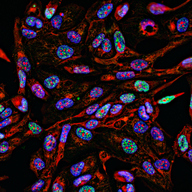CDN-Based Compounds and Conjugates for Cancer-Targeted Imaging, Diagnosis and Therapy
TECHNOLOGY NUMBER: 2021-270

OVERVIEW
Cyclic dinucleotide (CDN) selective accumulation in tumor tissues- A versatile and effective platform to reduce imaging signal-to-noise ratio
- May provide a means for treatment of cancer with targeted agents
BACKGROUND
Tumor-targeted imaging is a strategy for in vivo visualization of cancer and is used for accurate diagnosis, staging, and restaging of cancer. Existing imaging tools include positron emission tomography (PET), computed tomography (CT), magnetic resonance (MR), ultrasonography, and fluorescence. Contrast materials consist of substances that temporarily enhancing the ability for imaging tools to evaluate bodily structures. However, most of the currently available imaging contrast agents are distributed throughout the body, even in normal healthy tissues. This global uptake results in a low signal-to-noise ratio and causes side effects in some susceptible patients.Tumor-targeting imaging probes have emerged as powerful tools that improve tumor detection sensitivity and accuracy in staging diagnosis and treatment. A need exists to further develop tumor-targeted imaging agents with a high signal to noise ratio that would improve the clinical diagnosis of, and therapeutic options for, cancer.
INNOVATION
Researchers at the University of Michigan report that cyclic dinucleotides (CDNs) selectively accumulate in tumor tissues after systemic administration. Those CDNs found to efficiently collect in tumors include cyclic guanosine monophosphate-adenosine monophosphate (cGAMP) and cyclic di-GMP (CDG). CDNs can be conjugated with cyanine dyes that are commonly used for fluorescent labeling of DNA and RNA, such as Cy7 and Dy547. Using several in vivo animal models of cancer, CDNs and CDN-conjugates have been found to accumulate exclusively within tumors. These features allow the investigators to choose from a diverse library of CDNs for different applications and to conjugate and deliver various cargo molecules for different applications, including imaging, diagnosis, and therapy. CDNs have a short serum half-life and clear rapidly through kidneys, maximizing signal-to-noise ratio while minimizing any potential side effects.